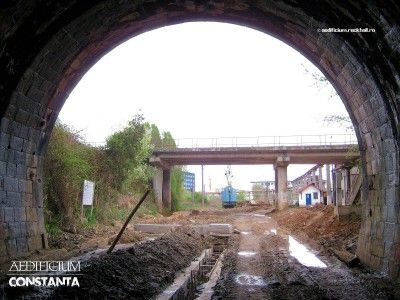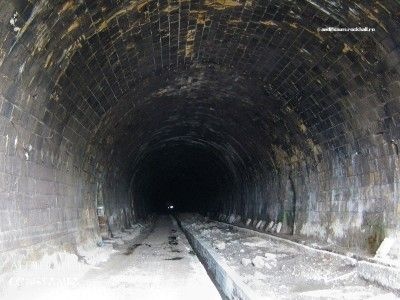Saligny’s Tunnel” that’s how it’s known by some of Constanta’s inhabitants. Not so many unfortunately, especially the youngsters have no idea of the existence of the tunnel that lays below their flats quarter. 


The tunnel was designed by Angel Saligny, whose name is related to a number of monumental buildings, the modern harbor of Constanta and the Cernavoda Bridge are the most famous. As an quote, Constanta harbor silos are assigned to Saligny too in the public conscience, but, although he has the highest merit in building these large silos, Saligny was an engineer, not an architect. The one who “designed” the buildings was architect Petre Antonescu, an important figure of the Romanian architecture school on the beginning of XXth century. Saligny handled the resistance calculations and supervised the construction of silos group. And he did it just great.
Returning to our tunnel, it was built between 1896-1900, so immediately after the opening of the Cernavoda Bridge. Saligny was at the apex of his creative force. The construction was a major engineering challenge and consisted of digging a double railway tunnel by using the of Roman arch technique – a solution that proved great durability over thousand of years all around Europe. The tunnel has a length of 490 m, width of 8.36 m and a maximum height (at the keystone) of 6.15 m; it’s build of a lining of bricks, mortar and a reinforced concrete slab, placed on a bed of stones. The tunnel features some niches on every 20 meters, those were intended as “hidings” for railway workers who were working inside, while the train traveled through the tunnel. There are many stories about those niches, as having connections with secret tunnels, Nazi munitions warehouses, terrorists nests and so on. There is absoluteli no proof in respect, at least at present.
Initailly named “Carol I Tunnel”, then known as Palas – Port C-ta passage, the railway tunnel functioned as an freight trains access to Constanta harbor for almost a century . The wall’s bricks were impregnated by steam and coal smoke of locomotives beginning of the century, for then to “smell” the Diesel locomotives exhaust. It was last time renovated in 1965, the tunnel proved to be extremely useful all along the years. And it still can be useful if there would have been some interest in regard.
After the 1970s, when the new railway route for the freight trains was launched, Saligny’s Tunnel continued to be a viable alternative, still making traffic on the old route. All until 1992, when, after some heavy rains, the embankment was swept by the waters and the tunnel was flooded. As it was happening in Romania, it remained flooded.
For 15 years no one (including the owner – CFR) did not even move a finger to see what is the tunnel state, and inside it has developed a real swamp ecosystem. The tunnel began to degrade and had massive infiltration of water. The walls began to “sprang” streams of water with a smell of sewage and oil, which also started to affect the structural strength. Questions and fears began to emerge from the residents of flats around, such as the tunnel is in danger of collapse and it would take the whole area with him. A nonsense, but all the panic had a positive effect – it has created pressure on the CFR administrators, and in 2011 it was decided to renovate of the tunnel.
It was thought that the tunnel will be rehabilitated and freight train traffic will be restored, many of us already imagined the trains coming out the tunnel , but the project proved to be aiming only on draining, removing of mud and debris and the construction of a new drainage channel. The work was carried out during summer 2012 and is now completed. The tunnel was drained, a new drainage channel was build on the center of the tunnel, and resins were injected in some areas to stop water infiltration – a solution on doubtful efficacyas long as a “stream” of water constantly flows through the new drainage channel.
In conclusion, the tunnel no longer “collapse”, but is also unusable. The rails were removed and the access was blocked. It’s on “preservation”. In its own “juice”.



